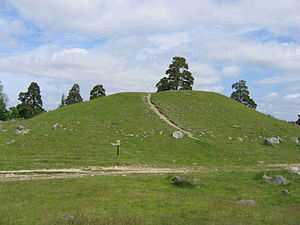Björn at Haugi

Björn at Haugi ("Björn at the Barrow" from the Old Norse word haugr meaning mound), Björn på Håga, Björn II or Bern was according to Hervarar saga a Swedish king and the son of Erik Björnsson, and Björn ruled together in diarchy with his brother Anund Uppsale:
| “ | The sons of Björn Ironside were Eric and Refil. The latter was a warrior-prince and sea-king. King Eric ruled the Swedish Realm after his father, and lived but a short time. Then Eric the son of Refil succeeded to the Kingdom. He was a great warrior and a very powerful King. The sons of Eric Björnsson were Önund of Upsala and King Björn. Then the Swedish Realm again came to be divided between brothers. They succeeded to the Kingdom on the death of Eric Refilsson. King Björn built a house called 'Barrow,' and he himself was called Björn of the Barrow. Bragi the poet was with him. King Önund had a son called Eric, and he succeeded to the throne at Upsala after his father . He was a mighty King. In his days Harold the Fair-haired made himself King of Norway. He was the first to unite the whole of that country under his sway.[1] | ” |
This account dates king Björn to the first half of the 9th century, as his nephew Eric Anundsson was the contemporary of Harald Fairhair.[2] Landnámabók mentions a Swede named Þórðr knappr who was one of the first settlers in Iceland and whose father was called Björn at Haugi.[2][3] Moreover, Björn and his court skald Bragi the Old are mentioned also in Skáldatal, where a second court skald also is mentioned, Erpr lútandi.[4][5]
A confirmation on the historicity of king Björn at Haugi is found in Rimbert's (d. 888) Vita Ansgarii, where he talks of a king Björn (rex Bern) and says on Ansgar's voyage in 827: "Tandem ad portum regni ipsorum, qui Byrca dicitur, pervenerunt, ubi benigne a rege, qui Bern vocabatur, suscepti sunt".[2] This king Björn is generally considered to be the same as Björn at Haugi[2][6] and this as early as Langebek[2] who lived in the mid-18th century. Some scholars have called this Bern "king of Birca", but this has no foundation in Rimbert's writings, as Rimbert writes that Ansgar went ashore in Birca, which was in king Björn's kingdom.[5] During Ansgar's visits there was also a Swedish king Anund who had been exiled but returned with Danish help,[7][8] and this Anoundus is the same as Björn's brother Önund,[8] who is mentioned in Hervarar saga.[1]
Notes and references
- ↑ 1.0 1.1 "Hervarar saga ok Heiðreks", Guðni Jónsson's and Bjarni Vilhjálmsson's edition at Norrøne Tekster og Kvad. English translation by N. Kershaw: "The Saga of Hervör and Heithrek" in Stories and Ballads of the Far Past, translated from the Norse (Icelandic and Faroese). Cambridge University Press, 1921.
- ↑ 2.0 2.1 2.2 2.3 2.4 Jónsson, Finnur (1890). "Om skjaldepoesien og de ældste skjalde", in Kock, Axel (Ed.). Arkiv för nordisk filologi, sjätte bandet. Ny följd: andra bandet. C.W.K. Gleerups förlag, Lund. p. 144.
- ↑ The relevant page of Landnámabók in the English translation at Northvegr.
- ↑ Skáldatal.
- ↑ 5.0 5.1 Jónsson, Finnur (1890). "Om skjaldepoesien og de ældste skjalde", in Kock, Axel (Ed.). Arkiv för nordisk filologi, sjätte bandet. Ny följd: andra bandet. C.W.K. Gleerups förlag, Lund. p. 143.
- ↑ The article Sweden in the Britannica of 1911.
- ↑ The article Anund in Nordisk familjebok (1904).
- ↑ 8.0 8.1 Medieval Sourcebook: Rimbert: Life of Anskar, the Apostle of the North, 801-865, in translation by Charles. H. Robinson.
| Björn at Haugi | ||
| Preceded by Erik Refilsson |
Semi-legendary king of Sweden with Anund Uppsale |
Succeeded by Olof and/or Erik Anundsson |